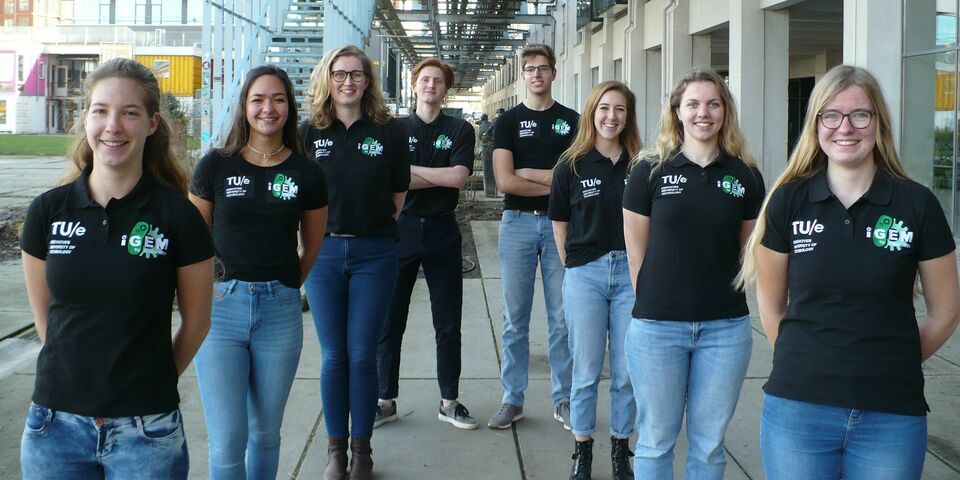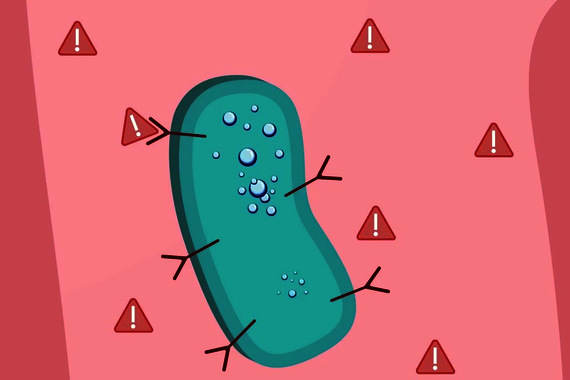Bacteria to detect intestinal inflammation
Following a corona year in which Eindhoven was absent from the iGEM student competition, the current TU/e team is now at work in the lab, developing a new method for monitoring intestinal inflammations. They are keen to use ultrasound to detect gas bubbles produced by genetically engineered bacteria close to the site of the inflammation.
Right after the first lockdown was announced last year, the iGEM team at the time decided to pull the plug, explains Josephina Smits (third from left in the main photo), the only team member to have stayed on this year. “It was soon evident that we couldn't use the labs and whether the competition was going to go ahead at all was doubtful; a waste of the registration fee, we thought.”
The annual competition - in which students apply techniques in the field of synthetic biology to solve all kinds of problems - did eventually take place last year, in the form of a fully online event; obviously the corona pandemic put paid to the customary Giant Jamboree held in Boston.
While lab space for students is still restricted on campus due to the corona measures, the quiet summer period afforded the current team three months' access to the lab facilities they needed. The iGEM team seized this opportunity to develop a method capable of revealing intestinal inflammations without the need of an endoscopic procedure.
Colonoscopy
A chronic inflammation in the intestines, known internationally by the umbrella term Inflammatory Bowel Disease (IBD), can be traced to a broad range of causes - Crohn's disease, affecting any part of the digestive tract, and ulcerative colitis, which affects the colon, are the most common. The Netherlands has some 90,000 IBD patients. The inflammations are not difficult to detect but the colonoscopy involved - a camera is inserted into the intestinal tract - is by no means pleasant.
“Added to which, the entire intestinal system must be empty, which means taking laxatives in the days prior to the procedure,” explains Smits. In short, not something you'd want to experience often; which is why, she says, questionnaires are mostly commonly used to monitor inflammations. “It would be better if you could reveal the inflammations with a simply ultrasound.”
Intestinal bacteria
The team is now hard at work attempting to detect gas bubbles in special bacteria with the use of an ultrasound device. “We have modified the intestinal bacteria E. coli so that they produce these bubbles when they encounter what is known as an inflammation marker - a protein that is present in the intestine as the result of an inflammation.” The thinking is that prior to the ultrasound patients will swallow the modified bacteria, contained in a special capsule that dissolves in the large intestine.
For now, though, the students are using a gel as their working environment. “We aren't allowed to do tests on people or animals; that would need more than three months in the lab anyway.” The gas bubbles not do leave the bacteria, Smits is keen to point out. “Your entire colon isn't going to swell up. The intention is to perform two ultrasounds in quick succession and in between to use ultrasound to burst the bubbles in the bacteria. By comparing the two ultrasound images, you should be able to reveal the location of the inflammation.”
Text continues below video
Digital
Owing to the unsettled situation arising from the corona pandemic, the participating teams have been asked by the iGEM organizers to prepare a digital presentation, in addition to a website where they will describe their project in detail. Depending on the situation in the fall, there may or may not be regional gatherings as well, explains Smits. Traditionally, ahead of the big final in November, the TU/e team organizes a jamboree for the Benelux. “Whatever happens, we hope this can go ahead. For the rest, we'll just have to wait and see.”



Discussion